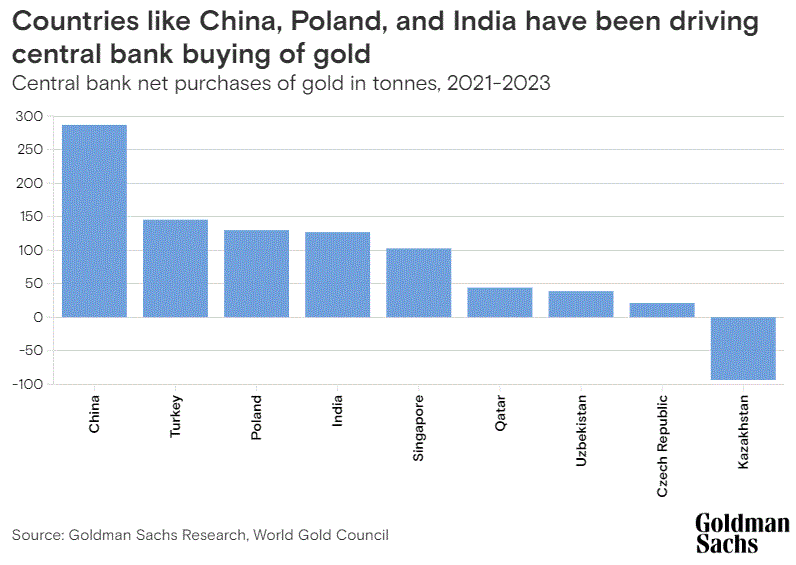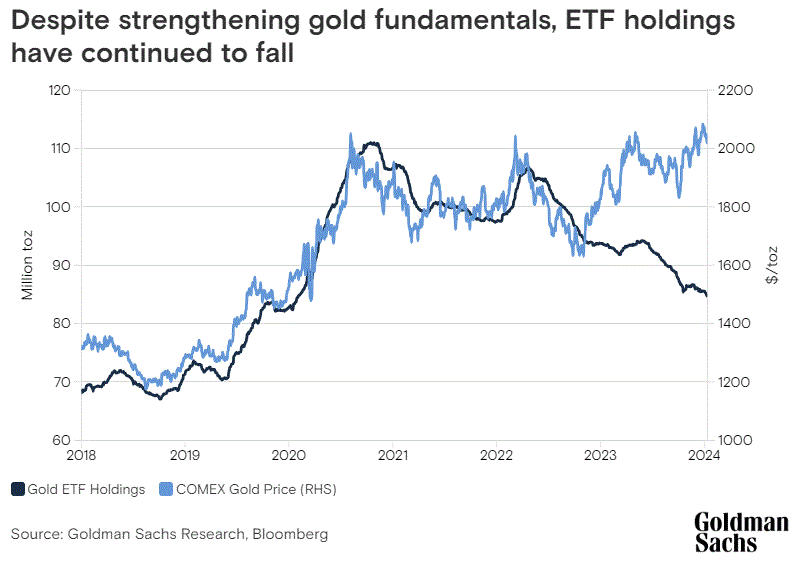
Nicholas Snowdon, who is in charge of the metal sector at the commodity research department, and analyst Lavinia Forcellese wrote in a Goldman Sachs report that the price of gold is projected to increase by about 6% in the next 12 months to $2,175 per troy ounce. They pointed out that in the short term, prices may fluctuate in the context of uncertain interest rate policies by the Federal Reserve (gold, which does not yield interest, tends to become less attractive to investors when interest rates are high, but until the January 2024 meeting, Fed officials have still emphasized that it is “too early to cut interest rates” and will not cut interest rates too quickly until “not certain it has won the fight against inflation”). However, the possibility of a drop in gold prices will be prevented by several key factors as follows:

Central banks like China, Poland, and India are pushing for gold purchases.
Central bank buying is taking place subtly and in a politically tense atmosphere.
Central bank buying of gold, especially from China and India, has helped compensate for the outflow of money from exchange-traded funds. Some of these purchases are driven by political tensions, such as the Russia-Ukraine conflict and the Covid pandemic.
Central banks have bought an average of 1,060 tons from 2022 to 2023, compared to 509 tons purchased from 2016 to 2019. This increase comes as China shifts its reserves away from the U.S. dollar and countries like Poland also boost their gold reserves.
Recently, a loss of confidence in the USD has prompted many central banks to actively diversify reserves, especially with gold. According to the World Gold Council (WGC), total gold demand is currently at its highest level since 2010 and is expected to continue rising into 2024.
Goldman Sachs analysts wrote, “We expect central bank buying activity to continue strongly due to the reserve diversification of emerging economies and increasing political tensions.”
Prior to this, Citibank also made the assessment that the global gold price could jump to $3,000 per ounce in a period of 12-18 months. According to Aakash Doshi, Head of North American commodity analysis at Citibank, global central banks have maintained more than 1,000 tons of gold reserves for two consecutive years, and if that number doubles to 2,000 tons, the gold price could rise to $3,000 per ounce.

The People’s Bank of China is increasing reserve diversification away from the USD and gold is an option.
Investment demand for gold has not yet recovered. The recent lack of enthusiasm by ETF funds to buy gold is likely due to the high levels of gold holdings, especially in comparison to real interest rates (interest rates adjusted for inflation). Major events, such as the Russia-Ukraine conflict and the Silicon Valley Bank crisis in the U.S., have driven gold buying activity in recent years, and the gold holdings of these funds remain high despite rising long-term interest rates in the U.S.
According to Goldman Sachs Research, speculative gold activity by hedge funds has recently fluctuated with changes in long-dated government bond yields. This suggests that gold is becoming more sensitive to changes in macroeconomic policies rather than the amount of gold held by ETF funds.

Gold holdings of ETF funds are decreasing.
In history, changes in gold holdings by ETF funds are often triggered by major events that reduce demand for risky assets and by monetary policy easing cycles. Goldman Sachs analysts expect ETF holdings to increase as the Fed begins to cut interest rates. Goldman Sachs predicts that the Fed may start lowering interest rates as early as May.
Retail gold demand remains strong. Meanwhile, the “wealth effect” from increased income in emerging markets is driving consumer demand for gold, particularly jewelry.
Goldman Sachs analysts wrote, “The ‘wealthy’ consumer group in India is growing rapidly… and will boost jewelry consumption.” “Furthermore, gold consumption is also supported by a lack of alternative investment options in certain countries experiencing major policy changes (Turkey, China…) in recent years.”

Gold benefits as Chinese stocks decline.
In China, gold is one of the best-performing assets in 2023, as weak consumer confidence and concerns about low growth prospects have increased demand for gold as a “safe haven”. About 40% of survey participants at the Goldman Sachs Global Macro Conference in Hong Kong believe that the gold price will exceed $2,200 per ounce by the end of 2024.
Goldman Sachs Research analysts wrote, “We predict that the property market downturn and investor concerns about the Chinese stock market will drive strong retail demand in China next year.”
Source: Goldmansachs.com





































